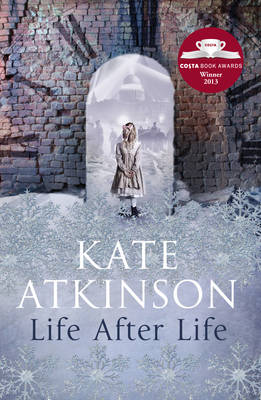The book is set up in life cycles – she dies multiple times but is essentially living out the same story with each life. Then the narrative will move on, beginning a new cycle of deaths and rebirths. Some lives go nowhere, but that’s realistic: it’s a sad fact of life that not everyone’s life is long.
And Ursula. Oh, Ursula. She is seriously the best narrator ever. Meeting Ursula so many times made me feel like I know her intimately; when one of her lives turned out to be horrible and depressing, my heart ached for her. I read some reviews that said it was boring spending so much time in Ursula’s head experiencing such similar events, but I found it uniquely rewarding. Atkinson also repeats phrases and images throughout Ursula’s lives, which gives each life a sense of poignancy and bittersweetness. In one instance, she repeats the image of “a black cat, a rhinestone for an eye”, and each time I was reminded of the horribly sad circumstances in which the image first appeared.
At the heart of it all, though, this book is not sentimental or frenzied. There is such a sense of Englishness about the book. This sums up what I mean perfectly: “‘No point in thinking,’ she said briskly, ‘you just have to get on with life. We only have one after all, we should try and do our best. We can never get it right, but we must try.’” It is uplifting, but also steel-faced in the midst of a horrible wartime. Even the small details – tea in the city, the summer countryside, etc. are perfectly done:
“She found Frieda slipping in and out of delirium and lay down beside her on the mattress on the floor. Stroking her damp hair, she talked in a low voice to her about another world. She told her about the bluebells in spring in the wood near Fox Corner, about the flowers that grew in the meadow beyond the copse – flax and larkspur, buttercups, corn poppies, red campion and ox-eye daisies. She told her about the smell of new-mown grass from an English summer lawn, the scent of Sylvie’s roses, the sour-sweet taste of the apples in the orchard. She talked of the oak trees in the lane, and the yews in the graveyard and the beech in the garden at Fox Corner. She talked about the foxes, the rabbits, the pheasants, the hares, the cows and the big plough horses. About the sun beaming his friendly rays on fields of corn and fields of green. The bright song of the blackbird, the lyrical lark, the soft coo of the wood pigeons, the hoot of the owl in the dark.”
Atkinson’s writing style is really unique too – and it kind of has to be to fit the unique concept. Each chapter’s title is a date, and most chapters are only a few pages long (although others are lengthy). Atkinson uses a lot of sentence fragments, which I find can work beautifully, especially with a concept that is so philosophical.
As I’m sure you can tell, there are so many elements that were so important for Atkinson to get right. What is so impressive to realize, after having finished reading, is how much work she put into Life After Life. So much thought. So many plot lines to keep straight. So many tiny details to make sure are perfect. Every aspect of this book was carefully considered and carefully written. Even the smallest supporting roles – which are so often dismissed easily – have been given such life and spark that they feel as important and real as Ursula herself.
Life After Life is the epitome of good taste, good writing, good thinking. I don’t care what your favourite genre is or what you normally read, this is a must-read for any reader. It is one of the most beautiful and accurate expressions of human life I have ever read. Felicitations, Ms. Atkinson.
